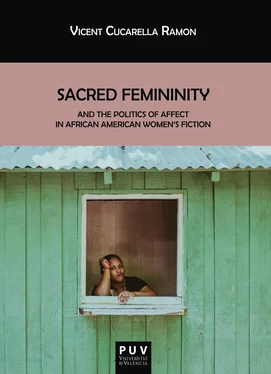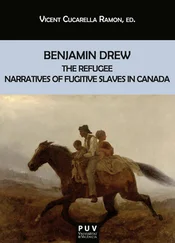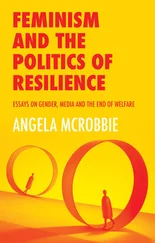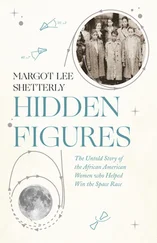For African American women, Christianity became an epistemological tool to overcome the discourses that relegated them as women, and thus, essentially inferior to men, as well as black subjects, and consequently outside the creeds that defined womanhood under highly repressive slavery times. Nonetheless, King acutely notes how for black women “to challenge biblical constructions of women… requires a different strategy from those adopted by many of their white contemporaries” (153). This is so because, contrarily to the experience of white women, black women had historically been associated and written as a body. Therefore, “any attempt to define woman in terms of the body can only be an essentializing project which evades the fact that the body is clearly not experienced in the same way by women of all races” (King 154). Accordingly, for African American women the only way to restore, and redefine, female spirituality is to invoke its healing powers just to “deconstruct the body/mind tradition” (King 155). The trope of the body is to be translated into the power of the word, namely, a new definition and interpretation of spiritual musings that can create a sense of unity and prosperity resulting into a rehabilitated image of that black female self. Black women promoted new and feminist readings of Christology considering that it is “grounded in the particular experience of the oppressed” (Grant 11).
This Christology—or else the capacity to stand in Christ’s shoes by means of an analogy that bespeaks a similar suffering—represented a good opportunity for black women to create a story of their own. The specific use of this theology, or the theology of the (socially) oppressed, might as well serve as the cultural weapon to liberate black women from the “Patriarchal Demon” (Grant 13). The feminist Christology to which African American women got attached is upheld in an overt context of “radical struggles in the process toward the liberation of women from social and political and ecclesiastical oppression” (Grant 18). Hence, black women’s conception of the sacred message that created a cultural web of feminine solidarity arises in the midst of in-between-ness: oscillating among resistance and a unique conception of a black feminine mode of atonement. What shimmers under these two cultural outlets and what eventually brings them together into a unique black feminine aesthetic, I propose, is the affective readings that African American women have historically impinged on Christianity aiming to counteract its primordial message.
The concept of affect began to gain momentum in the 1950s when Silvan Tomkins tried to separate what he called affect from emotion. Delving into the opening debates that led to new approaches to psychology and therapy, Tomkins afforded affect with a nuanced contrast to emotion because the latter contains memories and certain habit patterns. Thus, and taking the concept of affect as an axiom, “other emotion-related terms can be fitted into a solid theoretical framework and thereby given precise meaning” (Ostrofsky 4). The affect can be expanded to embrace ontological experiences not necessarily linked to a fixed understanding of the self. Brian Massumi posits affect as “what escapes our attention, as what haunts the representational realm rather than merely infusing it with emotive presence” and regards affect in terms of “ontological emergence that is released from cognition” (puar 2017). The politics of affect are characterized for creating an autonomous mode of self-representation, a motif aptly used by battered subjectivities to bring together a collective sense of community and being.
So, if affects “are transient” (Ostrofsky 4) but can be also attached to a functional aesthetic efficiency, their usage can be easily connected to a personal mode of spirituality. As Tomkins scholar Brendan I. McGroarty explains, according to the politics of affect theory, “the affects ultimately mold the interrelated process of perception, imagination, memory storage and retrieval, and consciousness. Because the affect system lays such a heavy claim on the human psyche, there are parallels between intense affective experience and religious experience” (57). Therefore, the politics of affect are suitable for women to link their quest for recognition with a spirituality that could give them enough room to both represent and heal themselves. This is so because, as Tomkins proposes, the “affect theory…accounts more fully for the role of perception and a wider use of imagination in motivation, recognizing the affects as its initial and primary source” (McGroarty 61).
There is a considerable amount of material written about the use of a personalized version of the Christian creed—unveiling a precise feminine spirituality—-on the hands of black women to uphold a new and rehabilitated version of themselves. This is the case of pioneering works such as Pat Crutchfield Exum’s Keeping the Faith: Writings by Contemporary Black Women (1974), Jeanne Noble ’s Beautiful, Also, Are the Souls of My Black Sisters: A History of the Black Woman in America (1978) or more recently Emily Townes’ edition A Troubling in My Soul: Womanist Perspectives on Evil and Suffering (1993) and Cheryl Townsend Gilkes’ If It Wasn’t for the Women (2001). However, nothing has been said about the merging ethos through which spirituality and affect interplay in the lives of African American women.
In my reading, Crafts, Hurston and Morrison display an array of female characters that revolve around their spiritual ethos understood only through bonds of emotional sharing and affective imports. Hence, through the use of affect, these authors try to recompose a healing sense of unity by bridging its effects with their specific construction of a religious creed. In this sense, they have used the politics of affect intermeshed in their own vision of spirituality to defend their own aesthetics in their writings. Suffice it to say, this has been a disharmonious matter because of the role that black women specifically have played within the religious cultural discourse. Infusing their writings with a spiritual vision and the politics of affect made Crafts, Hurston and Morrison create a black feminine aesthetic that served a twofold purpose: they reinvented themselves in the North American context and it helped them unite black women’s experience to foster global healing overcoming “the imposition of a strategy of identity” (1982: 94), as argued by Julia Kristeva in Powers of Horror: An Essay on Abjection .
Crafts, Hurston and Morrison use affect to complement their vision of the Christian creed although in different ways. However, they do converge in their usage of affect as an autonomous cultural outlet that renders a feminist reading of their novels. As stated earlier, affect fits within the conflicting message of Christianity since it allows black women to develop an autonomous ethos that allows them to make a sociocultural move forward while giving them a possibility to envision alternative ways of self-representation. On such an autonomous characteristic of affect Brian Massumi writes:
Affect is synesthetic, implying a participation of the senses in each other: the measure of a living thing’s potential interactions is its ability to transform the effects of one sensory mode into those of another… If there were no escape, no excess or remainder, no fade-out to infinity, the universe would be without potential, pure entropy, death. Actually existing, structured things live in and through that which escapes them. Their autonomy is the autonomy of affect (qtd. in puar 207).
This autonomous character of the affect theory resonates—albeit in various modes of representation—in The Bondwoman’s Narrative, Moses, Man of the Mountain and A Mercy . The three novels develop a ‘grammar of affect’ directly linked to spirituality. This grammar of affect, coined by feminist affect theorist Barbara Tomlinson, surfaces as an important term in the three analyzed novels. Tomlinson follows Tomkins and other affect theorists but adds the feminist perspective in an era of global interconnectedness. In this light, Tomlinson defines the grammars of affect in the allure of a feminist aesthetic by declaring that “(a)ffect is part of the authority of a text as it is constructed within a complex matrix of institutional norms, authorial statuses, privileges, and textual features that work together” (56). Or briefly put, “(a)ffect is deeply entwined with creation of textual authority” (56). The ethics of the affective turn, as Barbara Tomlinson additionally notes, transform “the terms of reading to foreground inflections of politics and power”, and “allows us to consider how specific norms of propriety, politeness, civility, and proper affect carry into academic arenas conceptions that are racialized, gendered, and profoundly classed” (56, emphasis added).
Читать дальше












